A rapid progressor-specific variant clone of simian immunodeficiency virus replicates efficiently in vivo only in the absence of immune responses
- PMID: 17596304
- PMCID: PMC1951398
- DOI: 10.1128/JVI.00614-07
A rapid progressor-specific variant clone of simian immunodeficiency virus replicates efficiently in vivo only in the absence of immune responses
Abstract
A subset of simian immunodeficiency virus (SIV)-infected macaques progresses rapidly to disease with transient SIV-specific immune responses and high viral loads. Unique SIV variants with convergent Env mutations evolve in these rapid progressor (RP) macaques. To address the pathogenic significance of RP-specific variants, we generated infectious molecular clones from the terminal-phase plasma of an RP macaque. Inoculation of macaques with a representative clone, SIVsmH635FC, resulted in a persistent viremia, comparable to that produced by pathogenic SIVsmE543-3, and a chronic disease with progressive loss of CD4(+) T cells. However, SIVsmH635FC did not reproduce the rapid-disease phenomenon. Molecular analyses of viruses from these macaques revealed rapid reversion to the wild-type SIVsmE543-3 sequence at two RP-specific sites and slower reversion at another three sites. SIVsmH635FC infection was not sufficient to cause rapid progression even following coinoculation with SIVsmE543-3, despite acute depletion of memory CD4(+) T cells. SIVsmH635FC competed efficiently during primary infection in the coinoculated macaques, but SIVsmE543-3 predominated after the development of SIV-specific immune responses. These data suggest that the replication fitness of the RP variant was similar to that of SIVsmE543-3 in a naïve host; however, SIVsmH635FC was at a disadvantage following the development of SIV-specific immune responses. Consistent with these findings, neutralization assays revealed that SIVsmH635FC was highly sensitive to neutralization but that the parental SIVsmE543-3 strain was highly resistant. This study suggests that the evolution of RP-specific variants is the result of replication in a severely immunocompromised host, rather than the direct cause of rapid progression.
Figures
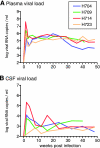
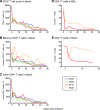


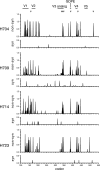
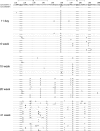

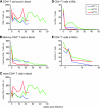

Similar articles
-
Infectious molecular clones from a simian immunodeficiency virus-infected rapid-progressor (RP) macaque: evidence of differential selection of RP-specific envelope mutations in vitro and in vivo.J Virol. 2006 Feb;80(3):1463-75. doi: 10.1128/JVI.80.3.1463-1475.2006. J Virol. 2006. PMID: 16415023 Free PMC article.
-
Unique pattern of convergent envelope evolution in simian immunodeficiency virus-infected rapid progressor macaques: association with CD4-independent usage of CCR5.J Virol. 2003 Jun;77(11):6405-18. doi: 10.1128/jvi.77.11.6405-6418.2003. J Virol. 2003. PMID: 12743298 Free PMC article.
-
Elite Control, Gut CD4 T Cell Sparing, and Enhanced Mucosal T Cell Responses in Macaca nemestrina Infected by a Simian Immunodeficiency Virus Lacking a gp41 Trafficking Motif.J Virol. 2015 Oct;89(20):10156-75. doi: 10.1128/JVI.01134-15. Epub 2015 Jul 29. J Virol. 2015. PMID: 26223646 Free PMC article.
-
Transient antiretroviral treatment during acute simian immunodeficiency virus infection facilitates long-term control of the virus.Philos Trans R Soc Lond B Biol Sci. 2000 Aug 29;355(1400):1021-9. doi: 10.1098/rstb.2000.0639. Philos Trans R Soc Lond B Biol Sci. 2000. PMID: 11186303 Free PMC article. Review.
-
Minimally Modified HIV-1 Infection of Macaques: Development, Utility, and Limitations of Current Models.Viruses. 2024 Oct 16;16(10):1618. doi: 10.3390/v16101618. Viruses. 2024. PMID: 39459950 Free PMC article. Review.
Cited by
-
Genetic similarity of circulating and small intestinal virus at the end stage of acute pathogenic simian-human immunodeficiency virus infection.Front Microbiol. 2013 Jul 22;4:204. doi: 10.3389/fmicb.2013.00204. eCollection 2013. Front Microbiol. 2013. PMID: 23885255 Free PMC article.
-
Sequential evolution and escape from neutralization of simian immunodeficiency virus SIVsmE660 clones in rhesus macaques.J Virol. 2012 Aug;86(16):8835-47. doi: 10.1128/JVI.00923-12. Epub 2012 Jun 13. J Virol. 2012. PMID: 22696650 Free PMC article.
-
Recognition of Apoptotic Cells by Viruses and Cytolytic Lymphocytes: Target Selection in the Fog of War.Viral Immunol. 2020 Apr;33(3):188-196. doi: 10.1089/vim.2019.0173. Viral Immunol. 2020. PMID: 32286181 Free PMC article.
-
Heavily glycosylated, highly fit SIVMne variants continue to diversify and undergo selection after transmission to a new host and they elicit early antibody dependent cellular responses but delayed neutralizing antibody responses.Virol J. 2008 Aug 4;5:90. doi: 10.1186/1743-422X-5-90. Virol J. 2008. PMID: 18680596 Free PMC article.
-
Correction of a carboxyl terminal simian immunodeficiency virus Nef frameshift mutation restores virus replication in macaques.Virology. 2010 Jun 5;401(2):207-14. doi: 10.1016/j.virol.2010.02.026. Epub 2010 Mar 19. Virology. 2010. PMID: 20303562 Free PMC article.
References
-
- Barouch, D. H., J. Kunstman, M. J. Kuroda, J. E. Schmitz, S. Santra, F. W. Peyerl, G. R. Krivulka, K. Beaudry, M. A. Lifton, D. A. Gorgone, D. C. Montefiori, M. G. Lewis, S. M. Wolinsky, and N. L. Letvin. 2002. Eventual AIDS vaccine failure in a rhesus monkey by viral escape from cytotoxic T lymphocytes. Nature 415:335-339. - PubMed
-
- Brown, C. R., M. Czapiga, J. Kabat, Q. Dang, I. Ourmanov, Y. Nishimura, M. A. Martin, and V. M. Hirsch. 2007. Unique pathology in simian immunodeficiency virus-infected rapid-progressor macaques is consistent with a pathogenesis distinct from that of classical AIDS. J. Virol. 81:5594-5606. - PMC - PubMed
-
- Carrington, M., G. W. Nelson, M. P. Martin, T. Kissner, D. Vlahov, J. J. Goedert, R. Kaslow, S. Buchbinder, K. Hoots, and S. J. O'Brien. 1999. HLA and HIV-1: heterozygote advantage and B*35-Cw*04 disadvantage. Science 283:1748-1752. - PubMed
Publication types
MeSH terms
Substances
Grants and funding
LinkOut - more resources
Full Text Sources
Research Materials

